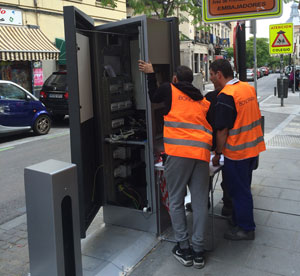For something that took years to arrive, Madrid’s public bicycles sure get off to a fast start. Pedal once and the 36-volt, 10-ampere, electric motors will give you a sudden boost. Going up one of Madrid’s many hills, it is a welcome aid. Downhill, the burst jars. But riders can disable the boost by not pedaling, and moderate it with electric controls on the handlebars. With a little practice, the bikes begin to feel like underpowered motor scooters. “Our major goal is to move journeys that are now done by car to the bicycles,” says Elisa Barahona, Madrid’s director of sustainability and environment.
During the program’s first week, however, almost nobody could sign up through the touchscreen UNIX computers at the bike docking stations. While first approved years ago in an effort to combat air pollution, economic concerns and then logistical problems delayed the launch by years, building up attention and demand. After the program finally launched, online attacks to the payment system blocked registration. In the first two weeks, the company’s information technology engineers racked up a 20 gigabyte log from Internet attacks, says Miguel Vital, director of Bonopark, the contractor operating the system on behalf of the city of Madrid. Other attacks were less sophisticated: Bonopark left some of the docking station computers’ screen resolutions at the wrong size, allowing at least one naughty user to access a web browser and leave pornography visible in the place of the user registration screen (The Local).
Now, after one month of service, BiciMAD, the long-delayed public bicycle system, is on its way toward its intended purpose, despite a handful of hitches. A fleet of nearly 1600 electric-assist bikes occupy 123 stations in the city center, supplementing a dense network of subways and buses, and competing with cars for space on the city’s streets. Within three weeks of launch, the system’s 8,000-odd users were making around 2500 daily journeys, reports El País. Bonopark’s Vital says that his company aims to recruit 90,000 users, who he predicts will make around 15,000 daily journeys, by the program’s fourth year.
By the time I got my hands on one of the gleaming white bikes, I had gathered opinions from Madrileños around the city. Those riding the bikes were enthusiastic; though there may have been a selection effect: they were the dedicated few who beat the sign-up hurdles and were willing to sign up for an annual pass. Others, looking puzzled, pawed at frozen touchscreens, or grumbled that the bikes charge for even the first half-hour’s use (a petition to change that has over 7,000 signatures). Many complained that the city was spending money on electric-boost bicycles instead of choosing cheaper human-powered models.
Yet Bonopark’s bid for the contract came in at a lower price than a competitor’s bid to provide the city with conventional bikes. As Barcelona and other hilly cities have discovered, people prefer to ride public bikes downhill, leaving shortages at hilltop docking stations and taking all the parking at valley stations. It costs operators (or cities) money to truck the bikes around. Madrid, like Copenhagen, offers riders a small discount if they pick up bikes from crowded stations or return them to stations with a bike shortage. And the first-half-hour charge is meant to free up the bikes for people looking to replace a longer car commute, instead of attracting pedestrians.
Already Madrileños are asking for an expansion of the service, which began in the most-polluted part of Madrid. The city’s air quality plan and contract for the bike sharing system foresees expansion mostly toward the north, in order to reduce pollution from cars.
Before then, though, Bonopark will need to sort out the information technology hiccups that hobbled the launch. For example, the IT team still hasn’t fixed the day-user signup form. As with Copenhagen’s smart bike sharing program, the success of Madrid’s bike-sharing is becoming as much a matter of silicon and electrons as steel, rubber, and sweat. IT may have been the biggest obstacle so far, but it has also been the salvation of 19 stolen bicycles. Police recovered the bikes within hours. Those big batteries are for more than just uphill climbs: they power a GPS unit and radio transmitter.
First published in IEEE Spectrum’s Tech Talk blog: [html] [pdf]

